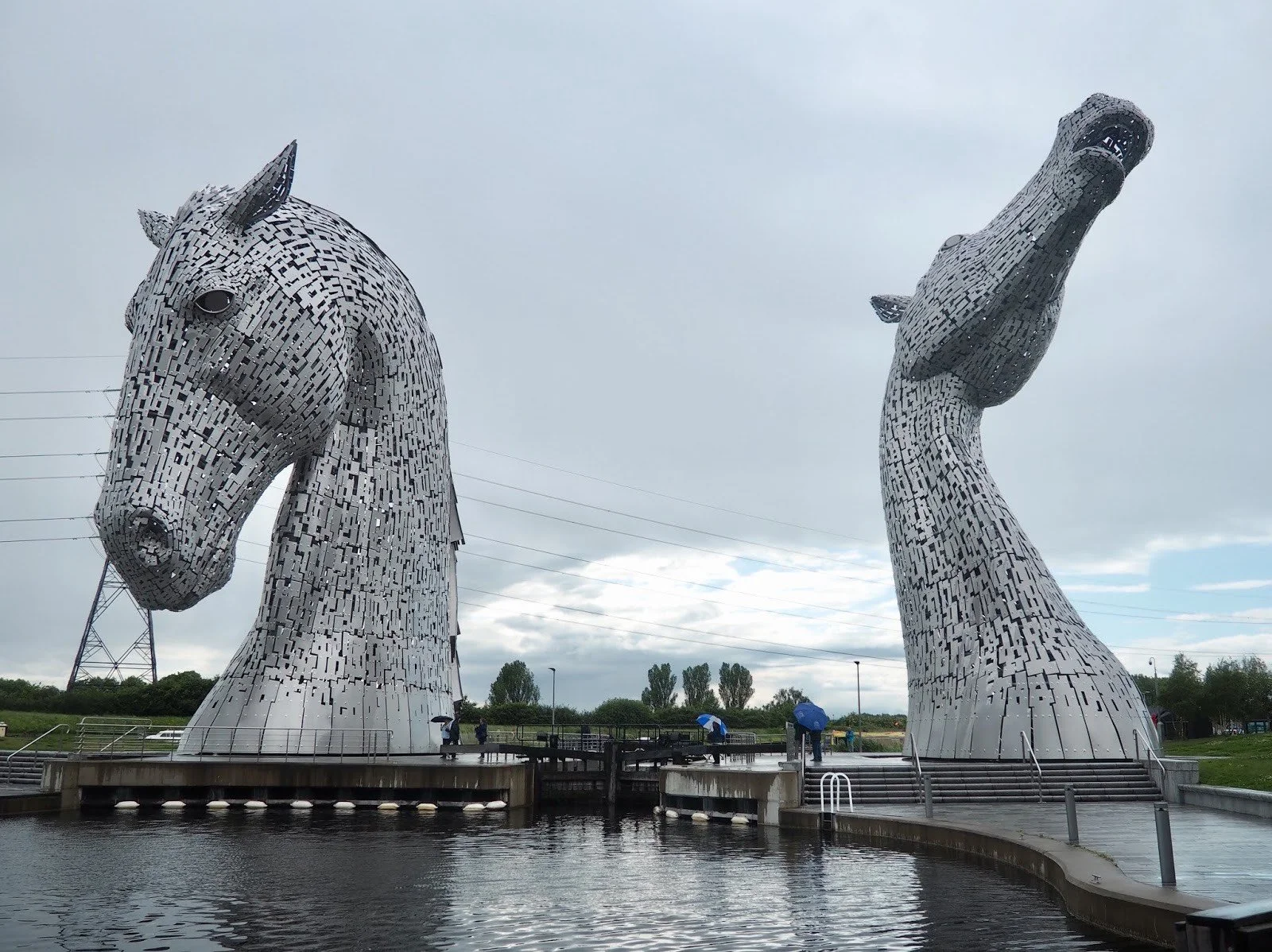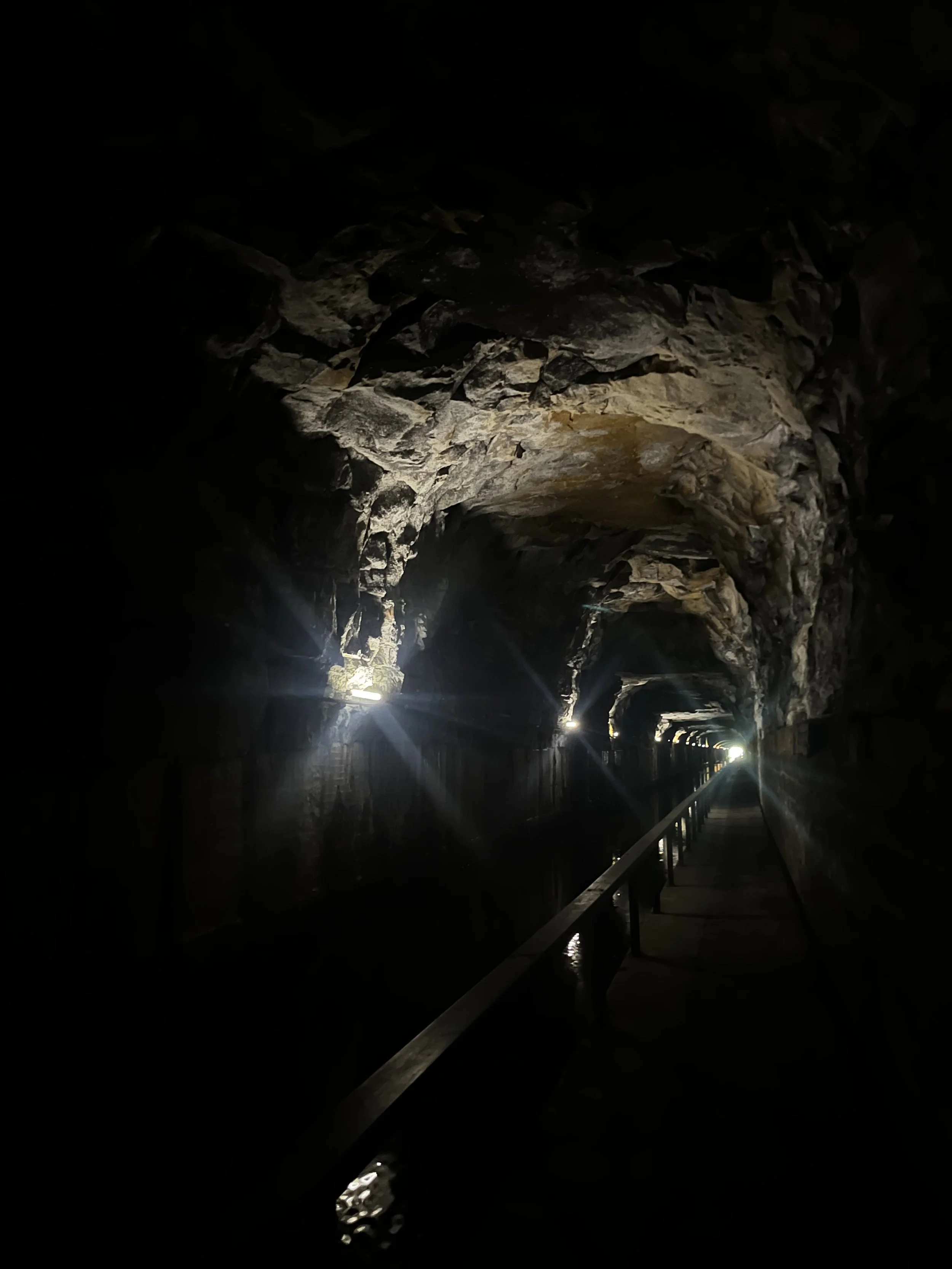Scotland's canals, the past and present wonders
Scotland's canals once the arteries for moving goods, people and raw materials. However with the rise in the railway system, that all changed. All too many canals became abandoned and forgotten, neglected to say. So, of course I went to discover this big part of Scotland's history.
The journey to learn about Scotland's canals starts at The Roadside attraction located in the outskirts of Falkirk known as the Kelpies. The two horses are such an iconic landmark in Scotland. What are the Kelpies? Well the Kelpies are a pair of 30 metre high steel sculptures designed by Scottish artist, Andy Scott. In mythology, Kelpies are shape-shifting water spirits and are said to haunt Scotland's lochs and rivers, often taking the form of horses. Completed in 2013, the Kelpies weigh 300 tonnes each and as mentioned, they have become a major tourist attraction. Importantly, they are located at the eastern side of the Forth and Clyde canal- Scotland's first canal which opened in 1790, connected the West Coast with the East Coast, and enabled ships to avoid the hazardous journey around Scotland's northern coastline.
Canals were built using manual labour in tough conditions with workers using simple tools like picks, shovels and wheelbarrows. Stone and brick were meticulously laid to line the canals, ensuring their durability and stability.
A main use of the Forth and Clyde canal was to transport whiskey from the Rosebank Distillery, which is located side by side next to the Forth and Clyde canal, which became majorly helpful as whiskey was transported from this distillery via the canal network. Established in 1840, it is a historic lowland whisky producer, renowned for its light, floral, and fruity single malts and certainly thrived during the 19th century, benefiting from its position near the Forth and Clyde Canal. Workers would load over the Whiskey onto the canal boats making an efficient way of transport after closing in 1993, the distillery was dormant for nearly 30 years until Ian MacLeod distillers acquired and restored it. Production resumed in 2023 with the distillery officially opening up to visitors in 2024, Rosebank continues its tradition of triple distillation and non peated whiskeys. I took the tour. Basic tours cost around £25 pounds. You can see the traditional whisky but if you care to buy it, they are all over £1000 for a bottle. But modern day ones are of a more reasonable price. Inside they do have the new make spirits, so that's whisky before it's put into the casks so it looks clear, somewhat like your vodka or gin. Then away in a cask it goes for a Minimum of three years to Mature into whisky.
In 1822 The Union Canal opened linking Edinburgh to the Forth and Clyde Canal, providing an inland connection to Glasgow. It was designed for lighter and smaller boats and was primarily used for passenger and agricultural transport. The longest canal tunnel to be built in Scotland is on the Union Canal, and although it is not a popular form of transport these days, with that now being taken up with the railway system, most canals are still there Some have been taken over by nature but it all just shows you never know what is hidden under the trees. I was keen to find out, so I next headed to the Falkirk Tunnel, that is used as part of the canal network. This tunnel was built between 1818 and 1822, designed by civil engineer Hugh Baird. To build it, rock was blasted with gunpowder, which was dangerous and time consuming, particularly given the lack of advanced machinery. It was built to accommodate the narrow boats of the time with a towpath for horses that pulled the boats. Horses were vital to the canal system, as they were capable of holding up to 50 times their own weight.
The Falkirk Tunnel is said to be an eerie and spooky tunnel, which I would confirm. An average walk through it will take about 15 minutes. As soon as you enter the tunnel, you can see the light from the other side, but it's a blur. The tunnel starts quite small and claustrophobic but then opens up to a big cave-like thing. There are lights, although the water is still so dark. It's 630 metres long and as it gets very dark at certain points, you are advised to not go in If you are scared from these sort of scenarios there is also loads of those stalagmites on the roof which you would see in a cave, but it is ever so cool and an experience that I didn't know was there for me, but I will remember forever.
Next stop the Falkirk Wheel where the Forth and Clyde canal connects to the Union canal.
The Falkirk Wheel is the only rotating boat lift in the world which opened in 2002 and successfully connects the Forth and Clyde canal with the Union canal. Previously, these two canals were linked by a series of 11 locks, which had fallen into disrepair and were replaced by the Falkirk Wheel. As part of the Millennium Link project to restore the country's inland waterways.The Falkirk Wheel has two gondolas that hold boats and water. Whenever it rotates the gondola's steel level due to archimedes principle making the lift highly efficient as gravity does most of the work. It takes 4 minutes and 50 seconds to complete a full rotation. It should take three days worth of energy from an average British household to rotate but with this philosophy it only takes the equivalent of boiling 8 kettles of water for a full rotation. It raises and lowers boats between the two canals, a staggering height difference of 24 metres from the union canal. The lift weighs about 1800 tonnes. And was built to last for at least 120 years The Falkirk Wheel has become a symbol of Scotland's Industrial Engineering Heritage.
So you can do what I did and book one of the two of the boats that go up and down the Falkirk Wheel joining the union canal, through a tunnel, and then turn back around and go downwards, which prior to the Falkirk Wheel would have taken nearly four hours. Now, it only takes 50 minutes. There are 8 boats a day with an average of 20 people on each boat. It is a very busy and popular experience for people to do, costing £17:50.
It is also very popular to rent a boat for a week. You can talk with somebody to aquire one and go to either to Edinburgh or Glasgow using the Falkirk Wheel to take you to the Union Canal from the Forth and Clyde. It takes 3 days to get to either of the cities and three days to come back, meaning you have to rent it for a week, costing £2500 pounds. You have to be with a minimum of two people to help drive the canal boat. If you were interested in buying your own it is roughly £150,000 to buy a new one, but you can find offers to buy second hand ones. Expect second hand ones to require more maintenance because they are in water, the canal and the boats get very rusty. You can also bring your campervan to the Falkirk Wheel and can park and stay there. It costs £15 per night. Showers and Toilets are included.
The decline of canals in Scotland began in the mid 19th century With the rise of the railway system, which offered faster and more efficient transport Many canals fell into disrepair, with some sections abandoned and neglected. However, in the late 20th century, restoration efforts began. Today, Scotland's canals are used for leisure booting and tourism. People also enjoy walking, cycling and other activities along their towpaths. The canals support local wildlife with ducks, swans and other birds often seen along the banks. Although there is an option to spend lots of money in this experience you can do all this for free just walking and taking it all in, seeing how it all works. I got a better idea watching the Falkirk Wheel from the bottom seeing it rotate because when you are on it is just such a smooth experience.
So everything I talked about from the Kelpies to the Rosebank Distillery, the tunnels, the Falkirk Wheel, all worth keeping it alive it is truly past and present wonders.
-TJ Lindie





